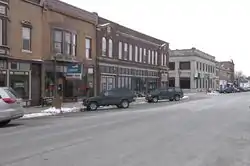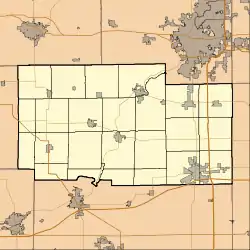Polo, Illinois
Polo is a city in Ogle County, Illinois, United States. The population was 2,355 at the 2010 census, down from 2,477 in 2000.
Polo | |
|---|---|
 Downtown Polo | |
| Motto(s): Gateway to the Pines | |
 Location of Polo in Ogle County, Illinois. | |
 Polo Location within Ogle County  Polo Polo (Illinois) | |
| Coordinates: 41°59′13″N 89°34′38″W | |
| Country | United States |
| State | Illinois |
| County | Ogle |
| Township | Buffalo |
| Government | |
| • Mayor | Doug Knapp (R) |
| Area | |
| • Total | 1.33 sq mi (3.46 km2) |
| • Land | 1.33 sq mi (3.46 km2) |
| • Water | 0.00 sq mi (0.00 km2) |
| Elevation | 863 ft (263 m) |
| Population (2010) | |
| • Total | 2,355 |
| • Estimate (2019)[3] | 2,171 |
| • Density | 1,627.44/sq mi (628.26/km2) |
| Time zone | UTC-6 (CST) |
| • Summer (DST) | UTC-5 (CDT) |
| Postal code | 61064 |
| Area code(s) | 815 |
| FIPS code | 17-60937 |
| Website | www |
History
The community was named after Marco Polo.[4] Polo was incorporated in 1856.[5]
Geography
Polo is located at 41°59′13″N 89°34′38″W (41.986852, -89.577100).[6]
According to the 2010 census, Polo has a total area of 1.36 square miles (3.52 km2), all land.[7]
Demographics
| Historical population | |||
|---|---|---|---|
| Census | Pop. | %± | |
| 1870 | 1,805 | — | |
| 1880 | 1,819 | 0.8% | |
| 1890 | 1,728 | −5.0% | |
| 1900 | 1,869 | 8.2% | |
| 1910 | 1,828 | −2.2% | |
| 1920 | 1,867 | 2.1% | |
| 1930 | 1,871 | 0.2% | |
| 1940 | 2,071 | 10.7% | |
| 1950 | 2,242 | 8.3% | |
| 1960 | 2,552 | 13.8% | |
| 1970 | 2,542 | −0.4% | |
| 1980 | 2,643 | 4.0% | |
| 1990 | 2,514 | −4.9% | |
| 2000 | 2,477 | −1.5% | |
| 2010 | 2,355 | −4.9% | |
| 2019 (est.) | 2,171 | [3] | −7.8% |
| U.S. Decennial Census[8] | |||
As of the census[9] of 2000, there were 2,477 people, 1,007 households, and 654 families residing in the city. The population density was 1,886.2 people per square mile (730.1/km2). There were 1,081 housing units at an average density of 823.2 per square mile (318.6/km2). The racial makeup of the city was 98.39% White, 0.04% African American, 0.20% Native American, 0.32% Asian, 0.04% Pacific Islander, 0.65% from other races, and 0.36% from two or more races. Hispanic or Latino of any race were 1.57% of the population.
There were 1,007 households, out of which 31.3% had children under the age of 18 living with them, 51.5% were married couples living together, 10.1% had a female householder with no husband present, and 35.0% were non-families. 31.0% of all households were made up of individuals, and 16.0% had someone living alone who was 65 years of age or older. The average household size was 2.40 and the average family size was 3.00.
In the city, the population was spread out, with 25.1% under the age of 18, 7.4% from 18 to 24, 26.8% from 25 to 44, 21.3% from 45 to 64, and 19.5% who were 65 years of age or older. The median age was 40 years. For every 100 females, there were 91.4 males. For every 100 females age 18 and over, there were 87.1 males.
The median income for a household in the city was $38,833, and the median income for a family was $46,250. Males had a median income of $37,857 versus $24,135 for females. The per capita income for the city was $18,604. About 7.2% of families and 9.2% of the population were below the poverty line, including 11.2% of those under age 18 and 10.0% of those age 65 or over.
Education
Polo has its own school district, Polo School District 222, which includes Polo Community High School, Aplington Middle School which grades are through 6th to 8th, and Centennial Elementary School which is Preschool to 5th.
Library
The Polo Public Library at 302 West Mason Street in Polo is operated by the Polo Public Library District. The building is one of several Carnegie libraries on the National Register of Historic Places. The library was established in 1871 as an association which charged a membership fee and was transferred to the town under the new name Buffalo Township Free Public Library in 1891.[10]
Notable people
- George Perkins Clinton (1867–1937), botanist and mycologist
- George Peek, economist
- Kathleen Weaver, writer and editor
See also
- Polo, Missouri, named after Polo, Illinois
References
- "2019 U.S. Gazetteer Files". United States Census Bureau. Retrieved July 14, 2020.
- "USGS detail on Newtown". Retrieved 2007-10-21.
- "Population and Housing Unit Estimates". United States Census Bureau. May 24, 2020. Retrieved May 27, 2020.
- Moyer, Armond; Moyer, Winifred (1958). The origins of unusual place-names. Keystone Pub. Associates. p. 104.
- Illinois Central Magazine. Illinois Central Railroad Company. 1922. p. 43.
- "US Gazetteer files: 2010, 2000, and 1990". United States Census Bureau. 2011-02-12. Retrieved 2011-04-23.
- "G001 - Geographic Identifiers - 2010 Census Summary File 1". United States Census Bureau. Archived from the original on 2020-02-13. Retrieved 2015-12-27.
- "Census of Population and Housing". Census.gov. Retrieved June 4, 2015.
- "U.S. Census website". United States Census Bureau. Retrieved 2008-01-31.
- "Polo Library History. Reprinted from 1 Voice of the Prairie: A Brief History of Polo, Illinois. Polo, IL, 1957". Polo Public Library District. Retrieved 2009-07-01.
External links
| Wikimedia Commons has media related to Polo, Illinois. |